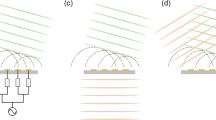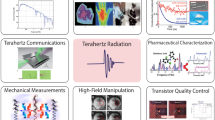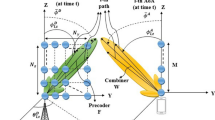Abstract
This paper presents a signal-level simulation model for simulating the process that antenna array of Aperture Synthesis Radiometer (ASR) collecting thermal radiation and transforming thermal radiation signal into radio frequency (RF) signal. By using the equivalent complex baseband signals to represent the practical thermal radiation and RF signals, simulation efficiency is improved significantly. The statistic characteristics of simulation results are found to match the corresponding theoretical analysis well. Results of an imaging simulation experiment show that this model can be employed in ASR system-level simulator design.



Similar content being viewed by others
References
F. T. Ulaby, R. K. Moore, and A. K. Fung, Microwave Remote Sensing Fundamentals and Radiometry vol. 1. (Addison-Wesley Publishing Company, Massachusetts, 1981), pp. 1–3, 135.
D. M. Le Vine, M. Hake, and C. T. Swift, Development of the synthetic aperture radiometer ESTAR and the next generation. Proceedings of IGARSS, 1260–1263, (2004).
C. S. Ruf, C.T. Swift, A. B. Tanner, and D. M. Le Vine, Interferometric synthetic aperture microwave radiometry for the remote sensing of the Earth. IEEE Trans. Geosci. Remote Sens. 26, 597–611 (1988).
D. M. Le Vine, A. J. Griffis, C. T. Swift, and T. J. Jackson, ESTAR: a synthetic aperture microwave radiometer for remote sensing applications. Proceedings IEEE (1994).
A. Camps, Application of interferometric radiometry to earth observation. in Department of Signal Theory and Communication. Vol. Ph.D. (Barcelona, Spain: Univ. Politecnica de Catalunya, 1996), p. 207, p. 73–84
I. Corbella, A. Camps, M. Zapata, F. Marcos, F. Martinez, F. Torres, M. Vall-llossera, N. Duffo, and J. Bara, End-to-end simulator of two-dimensional interferometric radiometry. Radio Sci. 38(3), 8058 (2003) DOI 10.1029/2002RS002665.
X. Zu Biao, H. Fei, and Z. Yao Ting, Design of simulation platform for synthetic aperture microwave radiometric detection system. J. System Simulation 19, 5663–5666 (2007).
C. S. Ruf, Numerical annealing of low-redundancy linear arrays. IEEE Trans. Antennas Propag. 41, 85–90 (1993).
R. M. Mersereau, The processing of hexagonally sampled two-dimensional signals. Proceedings IEEE, 1787–1801, (1979).
W. H. Tranter, K. S. Shanmugan, T. S. Rappaport, and K. L. Kosbar, Principles of Communication Systems Simulation with Wireless Applications. (Prentice Hall, New Jersey, 2003), pp. 95–115.
L. W. S. Guan, Methods for Radio Astronomy. (Science Press, Beijing, 1996), pp. 36–38, 107–108.
B. Davis, E. Kim, and J. R. Piepmeier, Stochastic modeling and generation of partially polarized or partially coherent electromagnetic waves. Radio Sci. 39, RS1001 (2004) DOI 10.1029/2001RS002512.
Z. Shu Jie, and Z. Jian Jun, Theory of Signal Detection and Estimation. (Tsinghua University Press, Beijing, 2005), pp. 52–54.
Acknowledgements
The authors would like to thank Prof. Qingxia Li, Dr. Zubiao Xiong, Dr. Liangbing Chen, and Dr. Fangmin He for their enthusiastic aids and encouragements.
Author information
Authors and Affiliations
Corresponding author
Appendix
Appendix
This appendix is devoted to modeling the process that individual antenna element collecting spatial thermal radiation. It is a power transformation corresponding to the signal transformation of Part-2.
Assuming that the apparent brightness temperature distribution T AP (θ, ϕ) which arrived antenna aperture is consisted of atmosphere element T DN (θ, ϕ) and point source element T p (θ, ϕ), the output brightness temperature of antenna is [1]:
Where Ω e is the pattern solid angle of antenna element, Ω p is the solid angle of point source relative to antenna, F n (θ, ϕ) is the normalized power pattern of antenna element.
In order to solve equation (16) numerically, antenna pattern is discretized. As it is shown in Fig. 4, θ and ϕ are divided into N and M equal divisions respectively. So the whole space is divided into N×M divisions with the solid angle of each division is:
Where \(\theta _i = i \cdot \Delta \theta \), i = 0, 1......N-1, \(N \times \Delta \theta = \pi \)
If N and M are large enough, the atmosphere brightness temperature distribution and normalized power pattern of antenna element are assumed to be constant T DN (θ i , ϕ j ) and F n (θ i , ϕ j ) respectively, in each ΔΩ ij ; If the point source is far enough, Ω p is less than ΔΩ ij , so the brightness temperature of point source is assumed to be a constant T p (θ p , ϕ p ) in Ω p , where (θ p , ϕ p ) is the direction of point source. Under these assumptions, (16) is given by
Where \(\varphi _j = \left( {j + \frac{1}{2}} \right) \cdot \Delta \varphi \), j = 0, 1......M-1, \(M \times \Delta \varphi = 2\pi \)
T DN (θ i , ϕ i ) and T p (θ p , ϕ p ) are derived from fabricated scene.
To discretely simulating the process that antenna collecting the spatial thermal radiation and making latter reconstruction process convenient, two point sources, whose radiation brightness temperature are T DN (θ i , ϕ j )ΔΩ ij and T p (θ p , ϕ p )Ω p respectively, are used to represent atmosphere radiation in ΔΩ ij and point source radiation in Ω p , respectively.
Rights and permissions
About this article
Cite this article
Li, Y., Dong, J., Chen, K. et al. Signal Level Simulation Modeling for Antenna Array of Aperture Synthesis Radiometer Based on the Equivalent Complex Baseband Representations. Int J Infrared Milli Waves 29, 663–672 (2008). https://doi.org/10.1007/s10762-008-9361-x
Received:
Accepted:
Published:
Issue Date:
DOI: https://doi.org/10.1007/s10762-008-9361-x





